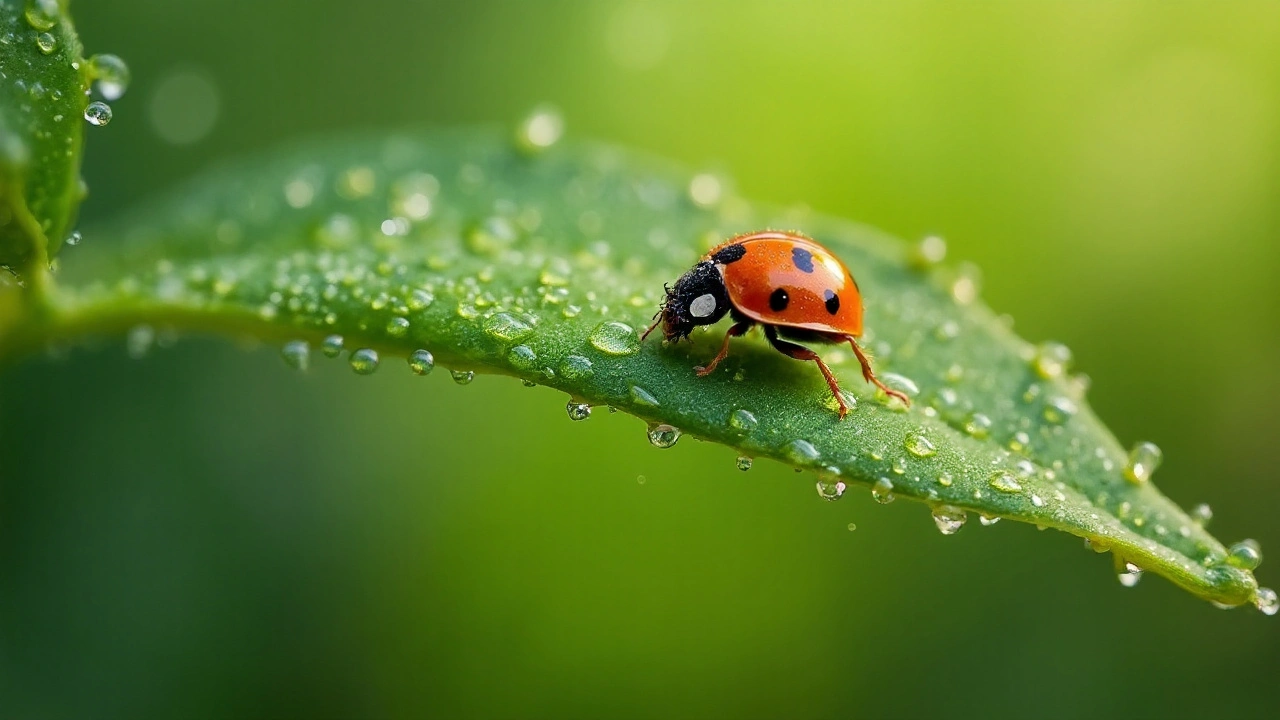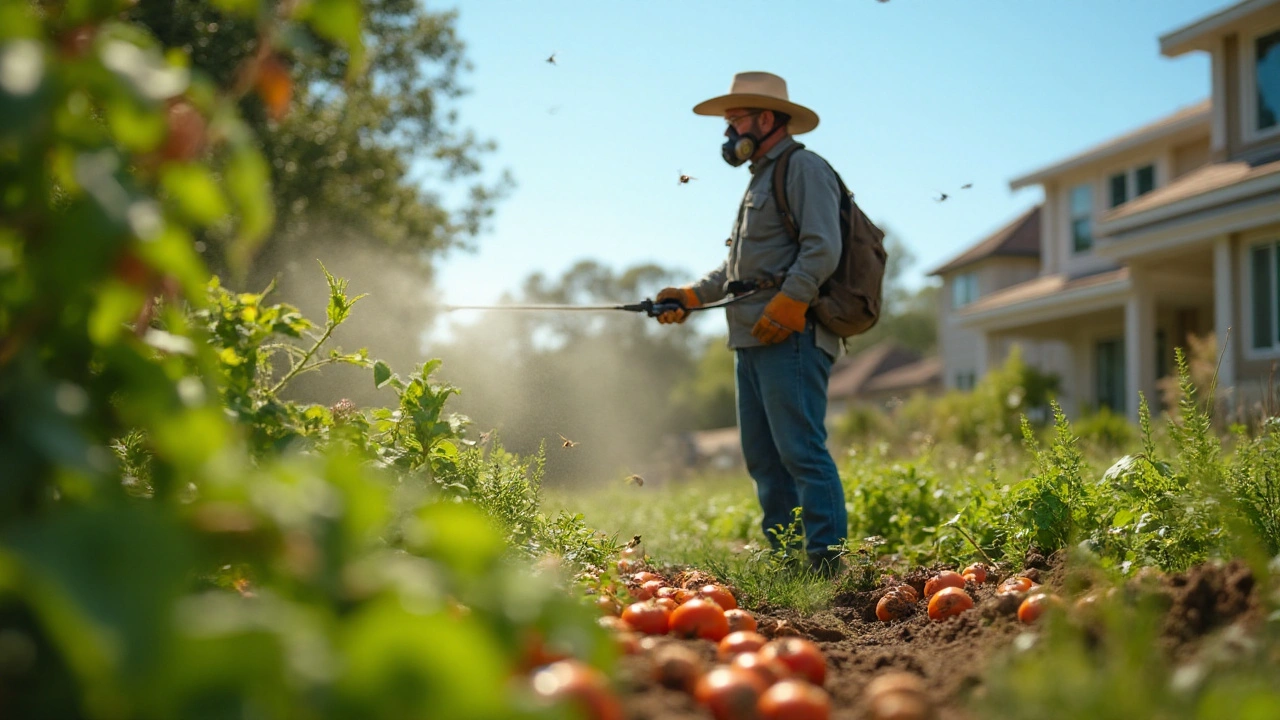Quick Summary
- Permethrin is a synthetic pyrethroid insecticide that works on contact and ingestion.
- Apply in early morning or late evening to protect bees.
- Follow EPA‑approved rates and wear proper PPE.
- Rotate with neem oil or copper to delay resistance.
- Integrate into an IPM program for long‑term garden health.
Permethrin is a synthetic pyrethroid insecticide that targets a wide range of garden pests by disrupting their nervous system. It was first registered for agricultural use in the 1970s and quickly became popular because it remains effective at low concentrations while breaking down relatively fast in sunlight.
For gardeners, the promise of a pest‑free bed is tempting, but using any chemical comes with trade‑offs. This guide walks you through the science, the safety steps, and the practical decisions you need to make to keep your tomatoes, roses, and lettuce thriving without harming pollinators or the environment.
What Is Permethrin and How Does It Work?
Permethrin belongs to the pyrethroid class, a group of chemicals modeled after natural pyrethrins found in chrysanthemum flowers. Unlike natural pyrethrins, which break down in minutes, permethrin’s molecular structure includes a bromine atom that extends its activity to several days under field conditions.
When a pest contacts treated foliage, permethrin binds to voltage‑gated sodium channels in the insect’s nerve cells. This forces the channels to stay open, causing repetitive firing of nerves, paralysis, and ultimately death. The mode of action is rapid-most insects succumb within minutes-but the effect is also reversible for insects that survive the initial dose, which is why proper dosing is critical.
When and Why Gardeners Choose Permethrin
Common garden nuisances that respond well to permethrin include:
- Aphids - sap‑sucking insects that spread viral diseases.
- Spider mites - tiny arachnids that cause stippling and leaf drop.
- Japanese beetles - voracious foliage chewers.
Gardeners often reach for permethrin when infestations spike suddenly and organic options lag behind. Its quick knock‑down effect can save an entire crop from irreversible damage.
Application Best Practices
Using permethrin safely starts with reading the label. The EPA mandates specific concentration limits for home gardeners (typically 0.5-2%w/v for spray mixtures). Here’s a step‑by‑step routine:
- Choose a calm, dry day. Wind speeds under 5mph reduce drift onto nearby flowers.
- Mix the product according to the label - usually one capful per gallon of water for a 0.5% solution.
- Wear PPE (gloves, long sleeves, eye protection).
- Apply using a low‑pressure backpack sprayer or a hand‑held pump. Ensure thorough coverage of both leaf tops and undersides.
- Treat at sunrise or dusk to keep bees away from the wet foliage.
- Wait the recommended re‑entry interval (usually 30minutes) before entering the treated area.
- Keep children and pets away until the spray dries.
- Record the date, product batch, and rate in a garden log for future reference.
After application, rinse equipment with plenty of water and dispose of any excess solution according to local hazardous‑waste guidelines.
Safety, Bee Protection, and Environmental Impact
One of the biggest concerns for gardeners is the effect on pollinators, especially bees. Permethrin is highly toxic to bees on contact, but it becomes much less dangerous once it dries and degrades under sunlight (half‑life≈12hours on foliage). Follow these safeguards:
- Never spray when flowers are in full bloom.
- Apply only to non‑flowering foliage or after the flowering period ends.
- Use a targeted spray or dust to limit coverage to pest hotspots.
- Consider buffer zones of at least 30feet between treated rows and bee‑friendly plantings.
Runoff can affect aquatic life. To minimise risk, avoid applying near ponds, and use a soil‑binding adjuvant if the label permits.
Integrating Permethrin into an IPM Program
Relying solely on chemical knock‑down breeds resistance. Integrated Pest Management (IPM) blends cultural, biological, and chemical tactics. Here’s a practical framework for a backyard vegetable garden:
- Monitor pest levels weekly with sticky traps and visual inspections.
- Set a threshold (e.g., 5% leaf area damaged) before intervening.
- Use cultural controls: rotate crops, maintain proper spacing, and water at the base to reduce humidity.
- Encourage natural enemies such as lady beetles and parasitic wasps. Plant dill, fennel, or alyssum as habitats.
- Apply organic options first - neem oil for aphids, copper fungicide for fungal issues.
- Reserve permethrin for breakthrough infestations that exceed thresholds despite the above measures.
- Rotate modes of action: after a permethrin treatment, wait at least two weeks before using another pyrethroid or a carbamate.
Documenting each step helps you spot patterns and makes future decisions data‑driven.

Resistance Management and Alternatives
Repeated use of a single insecticide can select for resistant pest populations. Studies from the University of California’s Integrated Pest Management program show that resistance to pyrethroids can develop in as few as five generations on high‑pressure crops.
Alternatives to consider:
- Neem oil - works as an antifeedant and growth regulator; safe for bees after 24hours.
- Effective against aphids, whiteflies, and soft‑bodied insects.
- Spinosad - a bacterial‑derived insecticide with a different neural target; low bee toxicity when applied correctly.
- Biological controls - release of predatory mites for spider mite infestations, or Bacillus thuringiensis (Bt) for caterpillars.
By alternating these tools, you keep pest populations off‑balance and preserve permethrin’s efficacy for those moments when you really need a rapid knock‑down.
Comparison of Common Garden Insecticides
| Attribute | Permethrin | Neem Oil | Spinosad |
|---|---|---|---|
| Primary Target | Broad spectrum (aphids, mites, beetles) | Aphids, whiteflies, soft insects | Caterpillars, leafminers, thrips |
| Mode of Action | Neurotoxin - sodium channel disruptor | Antifeedant & growth regulator | Neurotoxin - nicotinic acetylcholine receptor |
| Bee Toxicity (wet foliage) | High - avoid during bloom | Low after 24h dry | Moderate - apply evenings |
| Organic Certification | Non‑organic | Organic‑approved | Organic‑approved (certain formulations) |
| Pre‑harvest Interval | 0days (wash before eating) | 0days (wash) | 3days for leafy greens |
Tips for Maximising Effectiveness and Minimising Risks
- Calibrate your sprayer before each use - a 10% variance can mean under‑ or over‑dosing.
- Store permethrin in a cool, dry place, away from children and pets; label the container clearly.
- Rotate crops each season to break pest life cycles.
- Keep a garden journal; note weather, pest pressure, and product performance.
- When in doubt, test a small leaf area first to assess phytotoxicity.
Putting It All Together: A Sample Seasonal Plan
Below is a month‑by‑month outline for a typical UK garden (Bristol climate) that blends cultural tactics with targeted permethrin applications.
- March-April: Soil preparation, seed sowing, install row covers. No chemicals yet.
- May: Early scouting. If aphids exceed 5% leaf area, apply neem oil at 1%.
- Record dates in the garden log.
- June: Spider mite outbreaks common under warm, dry weather.
- Use a targeted permethrin spray (0.5% solution) at sunset.
- Follow with a hose‑down of beneficial insects the next morning.
- July-August: Peak beetle activity.
- Hand‑pick large beetles early in the day.
- For heavy infestations, apply permethrin again, respecting a 14‑day gap from the previous spray.
- September: Harvest begins. Wash all produce thoroughly.
- Cease all pesticide applications two weeks before the first frost.
By following this calendar, you harness permethrin’s speed while keeping the garden ecosystem balanced.
Frequently Asked Questions
Frequently Asked Questions
Is permethrin safe for edible plants?
Yes, when used according to the label. Permethrin breaks down quickly on plant surfaces, so a simple wash before consumption removes any residue. Do not apply within a day of harvest if you’re growing leafy greens for raw salads.
Can I mix permethrin with other garden sprays?
Mixing is generally discouraged unless the label explicitly permits it. Incompatible chemicals can create phytotoxic reactions or reduce efficacy. If you need to combine, test on a few leaves first and wait at least 24hours between applications.
How long does permethrin remain active on foliage?
Under full sunlight the active ingredient typically degrades to 50% within 12hours and is virtually gone after 48hours. Cloudy or cooler conditions can extend activity to 72hours, which is why timing around bee activity matters.
What personal protective equipment (PPE) should I wear?
Wear chemical‑resistant gloves, long sleeves, long pants, and safety glasses. If you’re spraying a large area, a half‑face respirator with P100 filters adds extra protection.
Will permethrin affect earthworms or soil microbes?
Permethrin is applied to foliage, so direct soil exposure is low. Studies show minimal impact on earthworm populations when used at label rates. However, repeated heavy applications can alter microbial balance, so rotate with non‑chemical soil amendments.
How can I tell if pests are becoming resistant?
If you notice the usual dose no longer reduces pest numbers after several applications, resistance is likely. Look for survivors that resume feeding within minutes. At that point, switch to a different mode of action and increase scouting frequency.
Is there an organic certification that permits permethrin?
No. Permethrin is synthetic and not approved for certified organic production. However, many hobbyist gardeners still use it on non‑organic beds while following best‑practice IPM guidelines.
With careful timing, proper protective gear, and a solid IPM plan, Permethrin for gardeners can be a reliable tool in the fight against stubborn pests-without turning your garden into a chemical wasteland.

Ellen Richards
September 24, 2025 AT 02:38Renee Zalusky
September 26, 2025 AT 02:05Scott Mcdonald
September 28, 2025 AT 00:44Victoria Bronfman
September 28, 2025 AT 06:51Gregg Deboben
September 29, 2025 AT 19:39Christopher John Schell
October 1, 2025 AT 01:31Felix Alarcón
October 2, 2025 AT 05:03Lori Rivera
October 3, 2025 AT 16:27Leif Totusek
October 3, 2025 AT 16:39KAVYA VIJAYAN
October 5, 2025 AT 11:51Jarid Drake
October 6, 2025 AT 22:03Tariq Riaz
October 8, 2025 AT 07:34